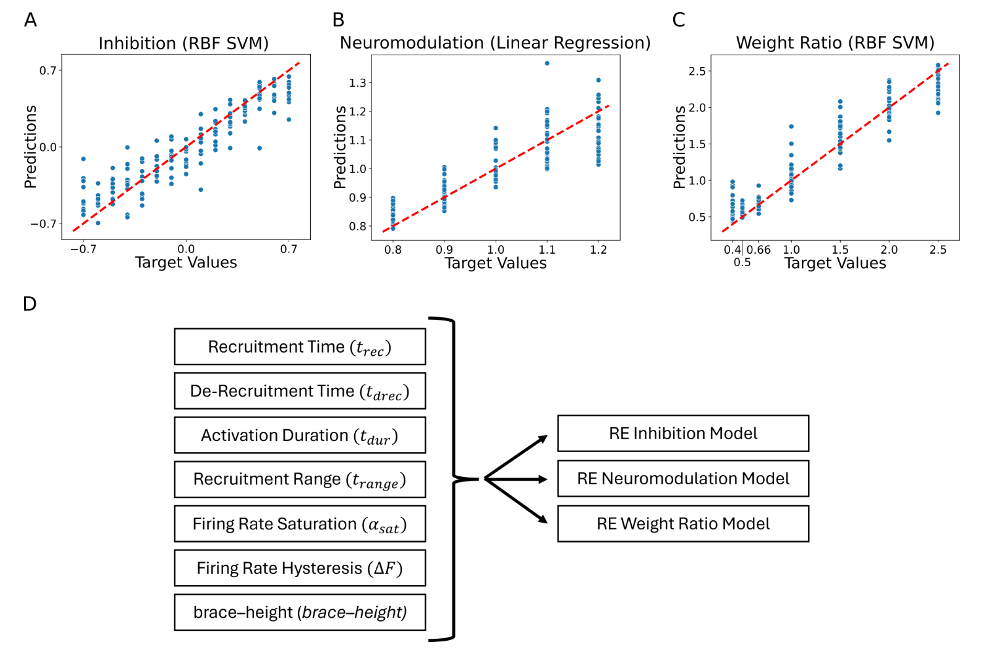Peer review process
Not revised: This Reviewed Preprint includes the authors’ original preprint (without revision), an eLife assessment, public reviews, and a provisional response from the authors.
Read more about eLife’s peer review process.Editors
- Reviewing EditorLeonardo EliasUniversidade Estadual de Campinas (UNICAMP), Campinas, Brazil
- Senior EditorPanayiota PoiraziFORTH Institute of Molecular Biology and Biotechnology, Heraklion, Greece
Reviewer #1 (Public Review):
Summary:
This research study utilizes a realistic motoneuron model to explore the potential to trace back the appropriate levels of excitation, inhibition, and neuromodulation in the firing patterns of motoneurons observed in in-vitro and in-vivo experiments in mammals. The research employs high-performance computing power to achieve its objectives. The work introduces a new framework that enhances understanding of the neural inputs to motoneuron pools, thereby opening up new avenues for hypothesis testing research.
Strengths:
The significance of the study holds relevance for all neuroscientists. Motoneurons are a unique class of neurons with known distribution of outputs for a wide range of voluntary and involuntary motor commands, and their physiological function is precisely understood. More importantly, they can be recorded in-vivo using minimally invasive methods, and they are directly impacted by many neurodegenerative diseases at the spinal cord level.
The computational framework developed in this research offers the potential to reverse engineer the synaptic input distribution when assessing motor unit activity in humans, which holds particular importance.
Overall, the strength of the findings focuses on providing a novel framework for studying and understanding the inputs that govern motoneuron behavior, with broad applications in neuroscience and potential implications for understanding neurodegenerative diseases. It highlights the significance of the study for various research domains, making it valuable to the scientific community.
Weaknesses: The exact levels of inhibition, excitation, and neuromodulatory inputs to neural networks are unknown. Therefore the work is based on fine-tuned measures that are indirectly based on experimental results. However, obtaining such physiological information is challenging and currently impossible. From a computational perspective it is a challenge that in theory can be solved. Thus, although we have no ground-truth evidence, this framework can provide compelling evidence for all hypothesis testing research and potentially solve this physiological problem with the use of computers.
Reviewer #2 (Public Review):
The study presents an extensive computational approach to identify the motor neuron input from the characteristics of single motor neuron discharge patterns during a ramp up/down contraction. This reverse engineering approach is relevant due to limitations in our ability to estimate this input experimentally. Using well-established models of single motor neurons, a (very) large number of simulations were performed that allowed identification of this relation. In this way, the results enable researchers to measure motor neuron behavior and from those results determine the underlying neural input scheme. Overall, the results are very convincing and represent an important step forward in understanding the neural strategies for controlling movement.
Nevertheless, I would suggest that the authors consider the following recommendations to strengthen the message further. First, I believe that the relation between individual motor neuron behavioral characteristics (delta F, brace height etc.) and the motor neuron input properties can be illustrated more clearly. Although this is explained in the text, I believe that this is not optimally supported by figures. Figure 6 to some extent shows this, but figures 8 and 9 as well as Table 1 shows primarily the goodness of fit rather than the actual fit. Second, I would have expected the discussion to have addressed specifically the question of which of the two primary schemes (push-pull, balanced) is the most prevalent. This is the main research question of the study, but it is to some degree left unanswered. Now that the authors have identified the relation between the characteristics of motor neuron behaviors (which has been reported in many previous studies), why not exploit this finding by summarizing the results of previous studies (at least a few representative ones) and discuss the most likely underlying input scheme? Is there a consistent trend towards one of the schemes, or are both strategies commonly used?
In addition, it seems striking to me that highly non-linear excitation profiles are necessary to obtain a linear CST ramp in many model configurations. Although somewhat speculative, one may expect that an approximately linear relation is desired for robust and intuitive motor control. It seems to me that humans generally have a good ability to accurately grade the magnitude of the motor output, which implies that either a non-linear relation has been learnt (complex task), or that the central nervous system can generally rely on a somewhat linear relation between the neural drive to the muscle and the output (simpler task). Following this reasoning, it could be interesting to report also for which input scheme, the excitation profile is most linear. I understand that this is not the primary aim of the study, but it may be an interesting way to elaborate on the finding that in many cases non-linear excitation profiles were needed to produce the linear ramp.




